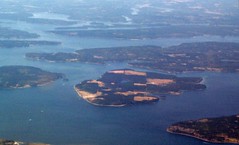Gooey duck | geoduck | mudpuppy | geoducks

Image by WorldIslandInfo.com via Flickr
The geoduck (gooey duck), Panopea abrupta, is a species of very large saltwater clam, a marine bivalve mollusk in the family Hiatellidae.
The shell of this clam is large, about 15 centimetres (5.9 in) to over 20 centimetres (7.9 in) in length, but the extremely long siphons make the clam itself very much longer than this: the “neck” or siphons alone can be 1 metre (3.3 ft) in length.
The unusual name of the clam is derived from a Lushootseed (Nisqually) word g?íd?q meaning “dig deep”, and its phonemically counterintuitive spelling is likely the result of poor transcription rather than anything having to do with ducks. Alternate spellings include gweduc, gweduck and goiduck. It is sometimes known as the king clam, or when translated literally from the Chinese characters, the elephant trunk clam.
Native to the northwest coast of the United States and Canada (primarily Washington and British Columbia), the geoduck is the largest burrowing clam in the world, weighing in at an average of one to three pounds (0.5–1.5 kg) at maturity, but specimens weighing over 15 pounds (7.5 kg) and as much as 2 meters (6 ft) in length are not unheard of[citation needed].
A related species, Panopea zelandica, is found in New Zealand and has been harvested commercially since 1989. The largest quantities have come from Golden Bay in the South Island where 100 tonnes were harvested in one year.
Geoducks are one of the longest-living organisms in the Animal Kingdom. They have a life expectancy of about 146 years, with the oldest recorded at over 160 years. Scientists speculate that the geoduck’s longevity is the result of low wear and tear. A geoduck sucks water containing plankton down through its long siphon, filters this for food and ejects its refuse out through a separate hole in the siphon. Adult geoducks have few natural predators, which may also contribute to their longevity. In Alaska, sea otters and dogfish have proved capable of dislodging geoducks; starfish also attack and feed on the exposed geoduck siphon.
Geoducks are broadcast spawners. A female geoduck produces about 5 billion eggs in her century-long lifespan—in comparison, a human female produces about 500 viable ova during the course of her life. However, due to a low rate of recruitment and a high rate of mortality for geoduck eggs, larvae and post-settled juveniles, populations are slow to rebound. In the Puget Sound, studies indicate that the recovery time for a harvested tract is 39 years.
Taken from: 





